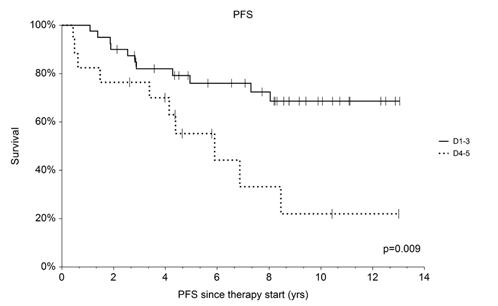
Contributions
Abstract: EP802
Type: E-Poster Presentation
Session title: Indolent and mantle-cell non-Hodgkin lymphoma - Clinical
Background
High-tumour-burden follicular lymphoma (HTB-FL) is a highly heterogeneous disease. About one-fifth of patients experience poor response to frontline therapy or early relapse within 24 months of treatment (POD24). Identification of early progression of the disease is still an unmet prognostic need. Use of positron-emission tomography/computed tomography (PET/CT) in the interim setting remains controversial.
Aims
To assess the impact of early metabolic assessment on early disease outcome
Methods
We analysed 124 previously untreated grade I-IIIA HTB-FL patients undergoing PET/CT at diagnosis and after immunochemotherapy, with 57 of them having early interim PET/CT scans within 14-21 days after the 2nd chemotherapy cycle. Imaging studies were conducted using the Siemens Biograph 16 HI-REZ (2008-2015) and Siemens mCT 40 (2015-2017) systems with the same image acquisition protocols at the same centre. Both PET/CT scanners were accredited by EARL, a European Association of Nuclear Medicine research initiative. Images were read by two independent experts blinded for patient outcome.
Results
The cohort consisted of 35 females and 22 males with a median age of 56 years, with advanced (CS III/IV) disease in 96.5%. The FLIPI/PRIMA-PI percentages were as follows: low 12%/31%, intermediate 44%/43% and high 44%/26%. All but one of the patients were treated with a rituximab-anthracycline-containing regimen (1 R-bendamustine) and 34 received rituximab maintenance. Forty-six patients (81%) achieved CR, seven (12%) achieved PR and four (7%) had stable disease or progressed on therapy. After a median follow-up of 8.4 years, twenty (35%) relapsed and eight died. Eight of them (14%) progressed/relapsed within 24 months of therapy. Interim PET-2 was assessed as negative (Deauville 1-3) in 40 (70%) and positive (D4-5) in 17 (30%) patients. End-of-induction PET scans were obtained in all but two patients (1 PD on therapy, 1 refusal), with 47 (85%) negative (D1-3) and eight (15%) positive (D4-5) results. Five-year PFS reached 55.2% and 79.2% (p=0.009) and 5-y OS 88.2% and 94.9% (p=0.017) in the D4-5 and D1-3 groups, respectively. Positive and negative predictive values were 58.8%/72.5% for PFS events and 29.4%/92.5% for death. The risk of a POD24 was 24% and 10% in the D1-3 and D4-5 groups, respectively.

Conclusion
Early interim PET/CT negativity is associated with a high negative predictive value for progression or lymphoma-related death. The risk of developing a POD24 event is reduced by 58% in the negative (D1-3) group. Interim PET/CT might be useful in identifying HTB-FL individuals at risk for immunochemotherapy failure. Larger analyses are needed to establish the role of interim PET in decision-making.
Acknowledgement: supported by AZV NU21-03-00411 and IGA_LF_2021_001 grants.
Keyword(s): Follicular lymphoma, PET, Prognosis
Abstract: EP802
Type: E-Poster Presentation
Session title: Indolent and mantle-cell non-Hodgkin lymphoma - Clinical
Background
High-tumour-burden follicular lymphoma (HTB-FL) is a highly heterogeneous disease. About one-fifth of patients experience poor response to frontline therapy or early relapse within 24 months of treatment (POD24). Identification of early progression of the disease is still an unmet prognostic need. Use of positron-emission tomography/computed tomography (PET/CT) in the interim setting remains controversial.
Aims
To assess the impact of early metabolic assessment on early disease outcome
Methods
We analysed 124 previously untreated grade I-IIIA HTB-FL patients undergoing PET/CT at diagnosis and after immunochemotherapy, with 57 of them having early interim PET/CT scans within 14-21 days after the 2nd chemotherapy cycle. Imaging studies were conducted using the Siemens Biograph 16 HI-REZ (2008-2015) and Siemens mCT 40 (2015-2017) systems with the same image acquisition protocols at the same centre. Both PET/CT scanners were accredited by EARL, a European Association of Nuclear Medicine research initiative. Images were read by two independent experts blinded for patient outcome.
Results
The cohort consisted of 35 females and 22 males with a median age of 56 years, with advanced (CS III/IV) disease in 96.5%. The FLIPI/PRIMA-PI percentages were as follows: low 12%/31%, intermediate 44%/43% and high 44%/26%. All but one of the patients were treated with a rituximab-anthracycline-containing regimen (1 R-bendamustine) and 34 received rituximab maintenance. Forty-six patients (81%) achieved CR, seven (12%) achieved PR and four (7%) had stable disease or progressed on therapy. After a median follow-up of 8.4 years, twenty (35%) relapsed and eight died. Eight of them (14%) progressed/relapsed within 24 months of therapy. Interim PET-2 was assessed as negative (Deauville 1-3) in 40 (70%) and positive (D4-5) in 17 (30%) patients. End-of-induction PET scans were obtained in all but two patients (1 PD on therapy, 1 refusal), with 47 (85%) negative (D1-3) and eight (15%) positive (D4-5) results. Five-year PFS reached 55.2% and 79.2% (p=0.009) and 5-y OS 88.2% and 94.9% (p=0.017) in the D4-5 and D1-3 groups, respectively. Positive and negative predictive values were 58.8%/72.5% for PFS events and 29.4%/92.5% for death. The risk of a POD24 was 24% and 10% in the D1-3 and D4-5 groups, respectively.

Conclusion
Early interim PET/CT negativity is associated with a high negative predictive value for progression or lymphoma-related death. The risk of developing a POD24 event is reduced by 58% in the negative (D1-3) group. Interim PET/CT might be useful in identifying HTB-FL individuals at risk for immunochemotherapy failure. Larger analyses are needed to establish the role of interim PET in decision-making.
Acknowledgement: supported by AZV NU21-03-00411 and IGA_LF_2021_001 grants.
Keyword(s): Follicular lymphoma, PET, Prognosis


